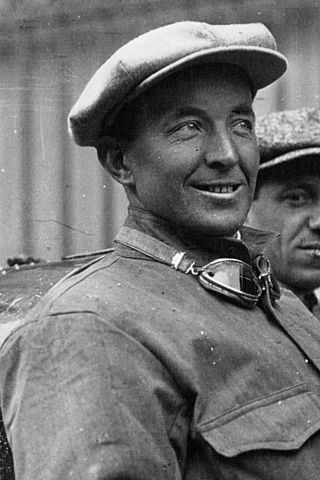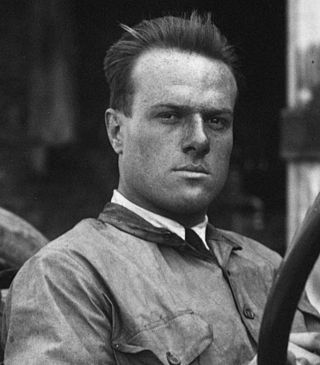
The United States Grand Prix is a motor racing event that has been held on and off since 1908, when it was known as the American Grand Prize. The Grand Prix later became part of the Formula One World Championship. As of 2023, the Grand Prix has been held 52 times at ten different locations. Since 2012, it has been held every year at the Circuit of the Americas in Austin, Texas, except in 2020 when it was cancelled due to the COVID-19 pandemic.

Ferenc Szisz, was a Hungarian racing driver and the winner of the first Grand Prix motor racing event on a Renault Grand Prix 90CV on 26 June, 1906.

Pietro Bordino was an Italian racecar driver.

Victor Hémery was a French racing driver. He was the winner of the Vanderbilt Cup in 1905.

The 1906 Grand Prix de l'Automobile Club de France, commonly known as the 1906 French Grand Prix, was a motor race held on 26 and 27 June 1906, on closed public roads outside the city of Le Mans. The Grand Prix was organised by the Automobile Club de France (ACF) at the prompting of the French automobile industry as an alternative to the Gordon Bennett races, which limited each competing country's number of entries regardless of the size of its industry. France had the largest automobile industry in Europe at the time, and in an attempt to better reflect this the Grand Prix had no limit to the number of entries by any particular country. The ACF chose a 103.18-kilometre (64.11 mi) circuit, composed primarily of dust roads sealed with tar, which would be lapped six times on both days by each competitor, a combined race distance of 1,238.16 kilometres (769.36 mi). Lasting for more than 12 hours overall, the race was won by Ferenc Szisz driving for the Renault team. FIAT driver Felice Nazzaro finished second, and Albert Clément was third in a Clément-Bayard.

Louis Auguste Wagner was a French racing driver who won the American Grand Prize and the inaugural British Grand Prix. Wagner was also a pioneer aviator.

David Loney Bruce-Brown was an American racing driver.
The 1906 Grand Prix season is regarded as the first Grand Prix racing season. It marked the advent of two iconic races: The French Grand Prix and the Targa Florio.
The 1907 Grand Prix season was the second Grand Prix racing season. It saw a blossoming of circuit events, with the shift from the inter-city races. The popularity of the inaugural French Grand Prix and Targa Florio saw those events held again. The new Kaiserpreis was the first major motor-race held in Germany. This year also saw a number of voiturette races as the number of specialist small-engine cars grew which gave close, exciting racing very popular with spectators.

The 1908 Grand Prix season was the third Grand Prix racing season. An international economic recession affected motor-racing with fewer races and smaller fields. However, in consequence, it also saw an increase in the number of smaller cars and voiturette racing. This gave close racing between the teams from Lion-Peugeot, Sizaire-Naudin and Delage. Both the major races in Europe, the Targa Florio and French Grand Prix, had precursor voiturette races, and along with the Coupe des Voiturettes, the honours were shared between those three manufacturers. This year’s Targa Florio had a small, but quality, field. Vincenzo Trucco won for Isotta-Fraschini with better mechanical reliability, after a close duel with the FIATs of Felice Nazzaro and Vincenzo Lancia.
The 1910 Grand Prix season was the fifth Grand Prix racing season. Because of the ongoing international economic recession, there were no Grandes Épreuves held. The American Grand Prize was held in Savannah.
The 1911 Grand Prix season consisted of Grand Prix races in the United States and Europe. It was a significant year as European racing gradually came out of the doldrums. A Grand Prix was held in France again. The first Indianapolis 500 was held at Indianapolis Motor Speedway, joining the American Grand Prize as a leading race.
The 1912 Grand Prix season saw Grand Prix motor racing in Europe and the United States. The growing economic confidence and interest from car manufacturers saw bigger fields and more races in the season. The French Grand Prix was held for the first time since 1908 and staged at Dieppe. The American Grand Prize was held in Milwaukee, moving from its previous home in Savannah.

The 1914 French Grand Prix was a Grand Prix motor race held at Lyon on 4 July 1914. Hailed as one of the greatest races of the twentieth century, it was a contest between the French Peugeots and the German Mercedes. For the first time, the Grand Prix was run to an engine limitation – of 4.5L maximum capacity. It was won by the Mercedes of Christian Lautenschlager who won at an average speed of 105.7 km/h (65.7 mph) after a tense seven-hour contest with the Peugeot of Georges Boillot.

The 1914 Grand Prix season consisted of Grand Prix races across Europe and the United States until abbreviated by the outbreak of World War I.
The 1915 Grand Prix season saw Grand Prix motor racing continue in the United States. Racing was suspended in Europe due to the outbreak of World War I. The American Grand Prize was held in San Francisco for the first time, in conjunction with the Panama–Pacific International Exposition. Several of the latest European cars had been imported to the USA before the war started. Briton Dario Resta had a Peugeot and Ralph DePalma raced one of the Mercedes GPs. While Resta won both races at San Francisco and DePalma won the Indianapolis 500, just ahead of Resta it was Earl Cooper, running a Stutz, whose consistency gave him the unofficial AAA national championship.

The 1922 Grand Prix season had several notable events during the year. The AIACR governing body brought in a 2-litre formula for Grand Prix. French companies brought out straight-8 engines for their cars but it was FIAT's 6-cylinder engine that took the trophies. Veteran Felice Nazzaro won the French Grand Prix, held near Strasbourg. It was a tainted victory though, as Nazzaro's nephew was killed when his FIAT's suspension broke in the latter stages of the race. An almost identical accident also happened to team-mate Pietro Bordino, though he was only slightly injured. Pierre de Vizcaya's Bugatti finished second, nearly an hour behind.

The 1923 Grand Prix season was part of a watershed year for motor racing that saw significant advances in motor-racing engineering, design and events. Fiat's chief designer, Guido Fornaca, developed the 805, the first supercharged car to win a Grand Prix. Benz appeared with the first mid-engined racer and, along with Bugatti and Voisin, produced some of the first efforts at aerodynamics on racing cars. With the United States also adopting the 2-litre formula, Harry Miller could use the smaller engine size to design the first single-seater race-car, ideally suited to American oval racing.
The 1908 Grand Prize of the Automobile Club of America took place at Savannah, Georgia on November 26, 1908.

The 1909 Grand Prix season was the fourth Grand Prix racing season. There were no Grandes Épreuves that year, as the economic recession of the previous year continued on. Renault had withdrawn from motor-racing and a number of French manufacturers, falling behind the success of their German and Italian rivals, followed suit. The French Grand Prix was cancelled, leaving the Targa Florio in Italy and Vanderbilt Cup in the United States as the only major races this season. With so little competition and financial incentive, technological advances ground to a halt. Emphasis shifted from racing to setting speed and endurance records. Benz & Cie built a new 12.4-litre racing-engine, and its 200 bhp derivative was put into the Blitzen Benz. This 21.5-litre monster held the Land speed record from 1909 to 1922, with various drivers starting with Victor Hémery in November, 1909 at Brooklands.













